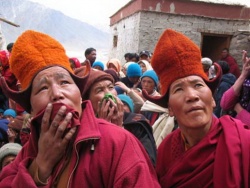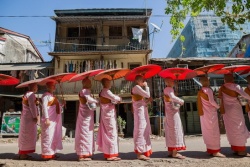BHIKKHUNI SASANA - The Order of Buddhist Nuns
The part played by women in the spread of Buddhism cannot be brushed aside as of little importance.
The Lord Buddha, purposely rejected three times, when Maha Pajapati Gautami his foster-mother requested for permission to establish the Order of Bhikkhuni (nuns). But, the Buddha at last yielded the well reasoned appeal of Venerable
Ananda as to how could sex stand in the way of attaining perfection and why should the women be deprived of the benefits of the religion. Therefore the Lord Buddha finally agreed, though not without misgivings about the ultimate result of such a step and he laid down certain conditions, which seem to imply the subservience of women to men.
The restrictions were as follows:—
However old a bhikkhuni may be, she must pay respect even to a newly ordained monk.
A bhikkhuni must not stay in a nunnery to observe the Buddhist Lent where there is no bhikkhu nearby.
A bhikkhuni must invite a bhikkhu every fortnight to fix the date of Sabbath and the day to listen to the exhortation (Ovada) of the monks.
A bhikkhunimust perform the ceremony of Confession and taking advice both in bhikkhus Sangha and bhikkhuni Sangha.
A bhikkhunimust observe the manattna discipline first from the bhikkhu and then from the bhikkhuni.
A bhikkhuni, after training in six pacittiya rules of bhikkhuni patimokkha , should seek upasampadafrom both bhikkhu and bhikkhuni sanghas.
A bhikkhuni must not revile a bhikkhu.
A bhikkhuni must not admonish a bhikkhu.
Moreover, the bhikkhunis were given the general directions that they should not indulge in such acts which would give rise to Desire (raga), Attachment (Sannoga), Acquisition (Acaya), Dissatisfaction (Asamtutthu) and so on. The mode of life prescribed for them was the same as that of the bhikkhualthough the disciplinary rules are partially different from that of the bhikkhu patimokkha.
For the bhikkhuni, sanction for ordination had to be taken twice, first from the bhikkhu and then from the bhikkhuni.One relaxable thing for a bhikkhuni is that she could send a messenger to the Sangha to seek an ordination on her behalf, when she was unable to present herself before the Sangha.
As a general rule, the bhikkhuni were not allowed to dwell in forests, and were prohibited from using beauty powder and fancy girdles; utmost caution is to keep the bhikkhu and bhikkhuni apart.
In the days of the Lord Buddha, this was a great step forward and in religious life, women enjoyed the same right of access to the highest position, as it recognized that women could also be as wise as men. In this connection, the names of distinguished bhikkhunis like Khema, Patacara, and Dhammadinna may be mentioned.
In the Therigatha also, women like Uppalavanna, Subha, Kisa Gautamiand Sama are referred to as having renounced the world out of unhappiness with life in general. They accepted a life of devotion in order to overcome mundane suffering.
Thus the Bhikkhuni Sasana had flourished. But after the Demise of the Lord Buddha, the Bhikkhuni Sasana dwindled away and disappeared. One thousand years afterwards women who wished to serve the Religion and to practise noble celibacy had no chance to become a bhikkhuni However the enthusiasts had observed the five precepts, eight precepts and ten precepts with the help of Venerable'Sayadaws.' They even shave their heads, adorn dyed clothes and practise the noble celibacy. These women were once called "Thedinthe" and are now known as 'Thilashins'(Buddhist nuns). These Thilashins practise learning and teaching religious canonical scriptures.
In present days the government of the Union of Socialist Republic of Burma has successfully convened the first Congregation of the Sangha of All Orders for purification, perpetuation and propagation of the Religion. This first congregation had formed the State Central Working Committee and the State Sangha Maha Nayaka Committee. The latter has prescribed rules for the organization of Thilashins. The objectives of the organization of Thilashins are as follows:—
(a) to practise the noble celibacy and lead her life with complete morality.
(b) to reside in nunneries unitedly according to the disciplinary rules provided for nuns.
(c) to promote the academic qualifications, and
(d) to maintain the noble practice of the Insight Meditation and Concentration.
In due course, divisional and township committees of Thilashinsare to be established. One interesting fact to note is that no State Central Thilashin Committee will be formed unless an emergency requiring discussion by such a body should arise.
The Congregation of the Sangha came to notice that Thilashins are not entitled to hold the National Registration Cards like laywomen. Therefore the Working Committee of the Sangha adopted a record of identity cards for Thilashins which would include name, residence, birth place, the time and date of becoming a Thilashin, address, name of parents and so on. Arrangements have been made to issue official records by Sangha Nayaka Committee of each township with the recommendation of the Sayadaw (Abbot) of the monastery where the Thilashins is residing, or by the Headmistress of the nunnery. The membership cards are to be issued only to nuns attaining the age of twelve and above. The Abbot or the Chief Nun must endorse the academic career in the records when ever the nun moves from one nunnery to another.
The Central Working Committee of the Sangha held its first annual meeting in four sessions on the 13th, 14th, 15th and 16th June, 1981 at Kaba-Aye, in Rangoon. On the third day of the meeting, the draft of constitutions for the organization of Thilashin was unanimously approved after thorough discussion.
Hence in the bright future bogus nuns who are not worthy of the Religion will vanish away and only bona fide Thilashins of good morality shall remain to help with the purification, perpetuation and propagation of the Buddha's Religion.



